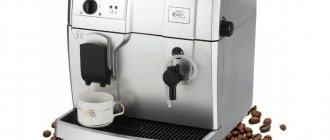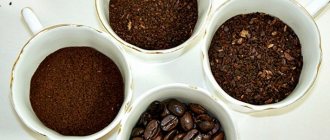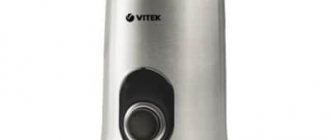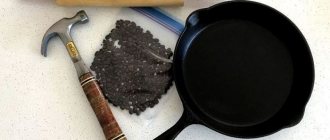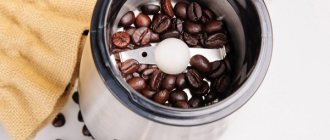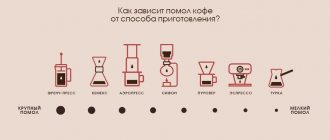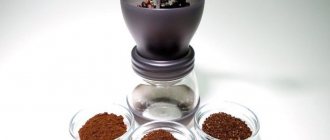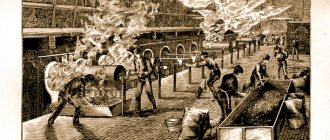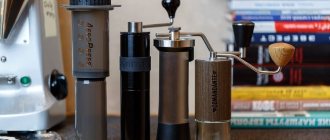After purchasing a professional coffee grinder, the company inevitably comes up with the question of correctly setting the coffee grinder for medium roast. Properly adjusted grinding is the basis for preparing espresso with a rich bouquet of taste and aroma. It is not always clear how to set the grinding correctly, but this important task does not require much time and effort if you follow a few rules.
Any barista knows that grinding affects the aroma and quality of the drink , so it is important for a coffee professional to be able to competently change the settings of a coffee grinder built into a coffee machine or standing alone. Without this, professional success of a barista is impossible. The choice of grinding is influenced by the method of brewing the drink and external factors: percentage of air humidity, room temperature, atmospheric pressure level. atmospheric conditions.
If you do not change the grind after the percentage of moisture in the air increases, the drink will become bitter because the particles swell, fit closer together and lengthen the brewing time of the coffee. In the case of a decrease in air humidity, the same mistake will lead to the appearance of an unpleasant sourness in the drink, since the coffee beans lose moisture, the distance between the particles becomes larger, and the extraction time of flavoring substances is shortened (not the entire bouquet of taste and aroma is boiled out of the grain).
When to change your coffee grinder settings
The coffee grinder settings must be changed in the following cases:
- Changing the type of coffee.
- If environmental conditions have changed: the air temperature has become higher or lower, the humidity level or atmospheric pressure has changed.
- If the coffee grinder knives have become dull (determined by uneven grinding). Knives require sharpening once a year.
There is no coffee grinder that will produce a completely uniform grind. In most cases, the ground beans will contain larger particles and coffee dust mixed in. To obtain high-quality coffee, you can sift the ground beans through a metal sieve of the required diameter to filter out particles that are too large or small.
When air humidity rises, coffee becomes bitter. As the humidity level decreases, it acquires a sour taste.
Rules for adjusting the grinding level
To select the desired degree of grinding, grind one portion of coffee, prepare espresso and measure the duration of extraction. If the drink is ready in 22 seconds or less, then it is recommended to make the grind finer; if the espresso is extracted for more than 28 seconds, increase it.
A professional coffee grinder is adjusted using a disk located under the hopper (a container for storing beans). To obtain a finer grind, rotate the disc towards the FINE inscription . This action can only be performed when the device is turned on. To make the grind coarser, turn the dial towards the COARSE inscription. You can increase the grind with the coffee grinder turned on and off.
One division unit on the disk is equivalent to 2-3 seconds of extraction. When adjusting the grind, it is important to remember that changing the grind does not change the other coffee settings. 7 grams of bean per single espresso (40 ml), pouring for 22-28 seconds. Correctly adjusted grinding will help to significantly save on grain consumption.
For you:
Purpose and replacement of the holder in the coffee machine
How to determine the dose for medium grind (for coffee ground into dust, add one to all numbers in the table):
| Unit of measure | Quantity, gram |
| Tea spoon | 4 |
| Heaped teaspoon | 6 |
| Tablespoon | 12 |
| Heaped tablespoon | 18 |
| Pinch | 0,5 |
| Matchbox "with a slide" | 6 |
To make delicious coffee, you need to use only freshly ground raw materials. The beans need to be ground 5-10 minutes before preparing espresso (or other coffee). Fresh coffee contains coffee oils that erode when exposed to air. If it is impossible to make freshly ground coffee every time, then the solution is to scatter the ground beans into different jars , 2-3 servings in each. In tightly closed containers, coffee will remain aromatic for 1-2 weeks.
Daniil Lobadin
Co-founder and head of the family manufactory Lobadin Coffee Roasters
Taking this opportunity, we repeat our favorite mantra: the grains need to be ground right before preparing the drink, do not stock up for a month in advance! It’s also great if a coffee lover has the opportunity to say goodbye to household blenders and blade coffee grinders: these machines produce an uneven grinding structure at the bean output, which means it’s not clear how to calculate the strength of the drink, and it’s not clear how to evaluate the taste of brewed coffee. But for the same or slightly more money that we would pay for a knife coffee grinder, you can buy a burr-type machine or a manual coffee grinder. Grinding the grains to the size of granulated sugar, ideally. Here, too, it is important to find a balance so as not to turn the entire supply of coffee into dust... well, here it is either a coffee grinder with a grinding level regulator, or practice-practice-practice.
— Daniil Lobadin Co-founder and head of the family manufactory Lobadin Coffee Roasters
Main types of coffee grinding
The taste, aroma and density of the coffee drink depend on proper grinding. Modern coffee grinders allow you to obtain different types of grinding. The guideline is personal preference and method of preparation.
There are several grinding methods.
- Coarse (course grind, coarse) – in appearance it resembles sea salt. Used for brewing in French presses. This consistency is obtained by running the coffee grinder for 10 seconds. To truly enjoy the drink, the beans are cooked in 8 minutes. before cooking.
- Medium grind – resembles sugar. Suitable for pour over, Chemex and geyser coffee makers. The grinding time is 13 seconds, the shelf life of the medium grind is 6 minutes before cooking.
- Fine (thin or fine grind) – similar in appearance to sand, slightly larger than powder. Suitable for use in drip and cone coffee makers. The device operates for 13 seconds, the ground grains must be used within 4 minutes.
- Espresso (fine espresso grind) grinding is carried out to the state of iodized salt for 20-25 seconds. The method was invented specifically for brewing espresso coffee, which is prepared in an espresso machine in 30 seconds.
- Ultrafine (powdery or pulverized). Grinding is carried out until the dry berries become similar in appearance to ground cinnamon. Prepared within 40 seconds and used to prepare a drink in a cezve and in a cup (Warsaw style). Powdered grinding cannot be stored.
At home, it is difficult to achieve uniform grinding; experts recommend additionally sifting the resulting powder through a strainer.
Important! The higher the mound that comes out of the coffee grinder, the finer the grind.
How to measure a dose of coffee
Ways to measure the right amount of coffee beans:
- Approximately. Unreliable method for beginners. Experienced baristas are able to measure the dose by eye without serious error. Exact dosage is not possible with this option.
- With the click of a coffee hopper. The coffee grinder has an error of 0.2 grams, so the dosage will remain inaccurate and will vary from portion to portion.
The ideal solution for weighing grain before grinding is to use an accurate scale with 0.1 gram increments for this purpose. You can buy inexpensive scales at a jewelry store or specialty coffee shops that are specifically designed for weighing coffee.
You should not try to artificially speed up the process of grinding coffee beans: if you do it too quickly, the grains will be too uneven, which will spoil the taste of the coffee. In addition, quickly ground coffee can heat up, resulting in a bitter drink with a burnt rubber taste .
If you follow all the instructions for proper grinding of beans, you will get coffee with excellent taste characteristics, which guests of the establishment will appreciate. And this will also reduce the consumption of coffee for preparing drinks.
For you:
Why does a barista need a pitcher?
How to Set Up a Manual Burr Coffee Grinder
Coffee grinders are divided into two large groups: manual and electric.
Electric coffee grinders operate using an electric motor and grind the beans using sharp knives.
Manual coffee grinders have a built-in burr mechanism. Millstones are made from ceramic or metal. The grinding process is done manually. The burrs are driven by a handle that is usually attached to the top of the grinder.
A manual coffee grinder is simpler than an electric one: it does not have a motor. But burr coffee grinders provide more uniform grinding and do not heat the coffee, so they are valued higher. In a burr coffee grinder, you can easily change the degree of grinding by changing the distance between the millstones. The downside of this device is the grinding speed. An electric coffee grinder handles beans many times faster than a manual one.
We tell you how to change the grinding degree of grain in a manual coffee grinder equipped with conical millstones.
To change the degree of grinding of coffee beans, the position of the upper millstone is changed; another name for it is “runner”. The lower millstone cannot be rotated!
Moving the runner upward makes the distance between the millstones larger and increases the size of the ground grains.
To reduce the distance between the millstones and make the grind finer, the slider is moved down. It is important not to make the distance too small: this will cause the millstones to wear out quickly and may jam.
Algorithm for moving the runner:
- Remove the handle by unscrewing the nut that secures it.
- Remove the washer.
- Unscrew or tighten the adjusting nut, depending on whether you need to make the grind finer or coarser.
- Return the washer and other elements to their original position.
Mode settings
Setting the extraction time + grinding degree allows you to create the taste of the product while the coffee machine is operating. Typically the extraction lasts 8-20 seconds. In a short time range of up to 8 seconds, the beans will not release all the caffeine and beneficial components to the hot water. If the period is longer than 20 seconds, the drink will become bitter and will not have a normal taste. The extraction time is affected by the size of the grains. The grain is finer, the extraction will take longer. Larger fraction means shorter process. The grinding setting is adjusted manually. These factors are the most important. There is no normal setting - no beneficial substances will be extracted, there will be no invigorating caffeine.
Cunill Tranquilo TRON: adjusting grinding and working with settings
Setting up the Cunill Tranquilo TRON coffee grinder is distinguished by the ability to finely adjust the grind size. The size of the dispensed portion varies from 5 to 12 grams, which allows you to save grain consumption.
The device allows you to set the dose for single and double portions. It is possible to program a third dose option - individual.
The finest grind is ideal for making coffee in a cezve. The coffee grinder does an excellent job of grinding espresso. The ground grains do not clump, the grinding is uniform.
A coarse grind for French press or alternative methods is also highly commendable. The particle diameter is about 3 mm, the grinding is uniform, without dust or other defects.
The coffee grinder gently grinds coffee beans and does not break them, as cheap machines with imitation millstones do. Coffee retains its aroma.
Coffee ground in this machine retains its natural aroma, does not lose its richness, and does not acquire impurities. This characteristic is important for any brewing and grinding method: French press, filter, espresso or cezve.
All of the above advantages are only relevant if you use the highest quality coffee beans. Coffee must be roasted in compliance with all rules, and green beans must meet quality standards.
What should you consider when selecting grinding according to the table?
— The sifting results showed that some coffee grinders produce more dust (for example, EK 43 with turkish millstones (we are talking about new turkish grinders, not the old ones that were in production before 2015). This is an important factor that should be taken into account when grinding ratio, since More dust may slow down extraction.
— Wear of millstones. Sieving was carried out on relatively new equipment.
— Calibration of your coffee grinder to 0 and to the planes of the millstones.
— Correct determination of the axis of your coffee grinder (applies to Comandane coffee grinders). Comandante coffee grinders can have two types of axles: Red Clix (it is red) and a standard axle (black). Red Clix: Changes grind size to 15 microns in one click. And the standard axis is 30 microns.
— For sifting, we used a coffee grinder with a Red Clix axis. So if you have a standard axle, you divide the grind value for the Red Clix by 2. For example, from our table you found out that on the Comandante (Red Clix) you need a grind of 40 clicks. This means that on a Comandante with a standard axle it will be a grind of 20 clicks.
— It is also necessary to take into account that on some coffee grinders (for example, Feldgrind), in the position of the converged millstones, it is necessary to set the zero so that the zero converges on the adjustment knob. That is, you reduce the grinding until the millstones are as close as possible. And in this position (when the millstones are brought together), the grinding indicator should be at number 12 (see photo 1). This is zero in our case. If the pointer is on any other number, then you need to calibrate the coffee grinder according to the instructions.
— The Mazzer ZM coffee grinder comes with espresso millstones and filter millstones. The thing is that the sharpening of the millstones is the same, but their thickness is different. Our espresso grinder has burrs. If you have millstones for a filter, then you just need to add 150 microns. For example, 400 microns on a Mazzer ZM with espresso burrs will correspond to 550 microns on this coffee grinder with filter burrs.
Friends, if you want to see any other coffee grinders in the table, send them to us, we will sift them and add them to the table. But the main condition is that it be a high-quality coffee grinder, with axial bearings and precise grinding adjustment.
So, grinding is one of the most important parameters when setting up a recipe. But please remember about the others too.
Here's an example for clarity. We brewed two identical funnels: the same recipe, grinding, etc. The only difference between them is the filter (see Table 3). The first funnel is brewed using a Hario filter. And the second funnel is with the FAST filter from Sibarist.
–The FAST filter gives us the opportunity to take a fresh look at extraction and grinding. For example, we can make the grind much smaller and extract more from the coffee without over-extracting it. You can find out more information about these filters here: https://sibarist.coffee/en/products/fast/

